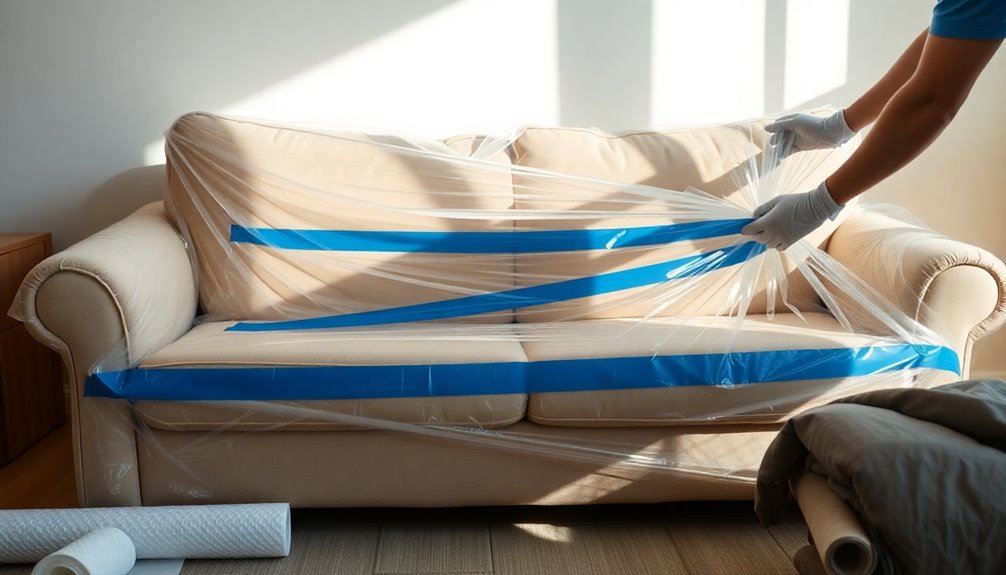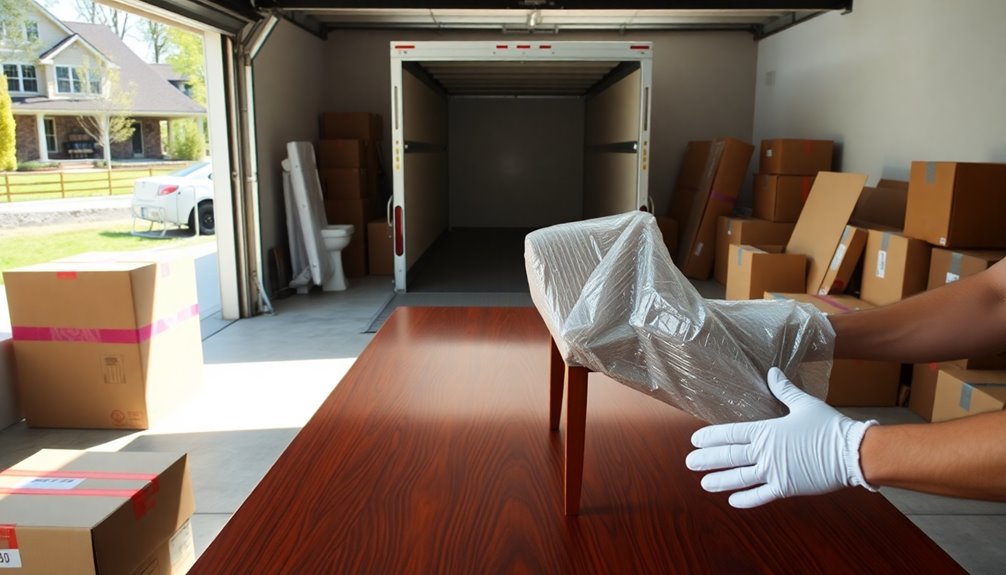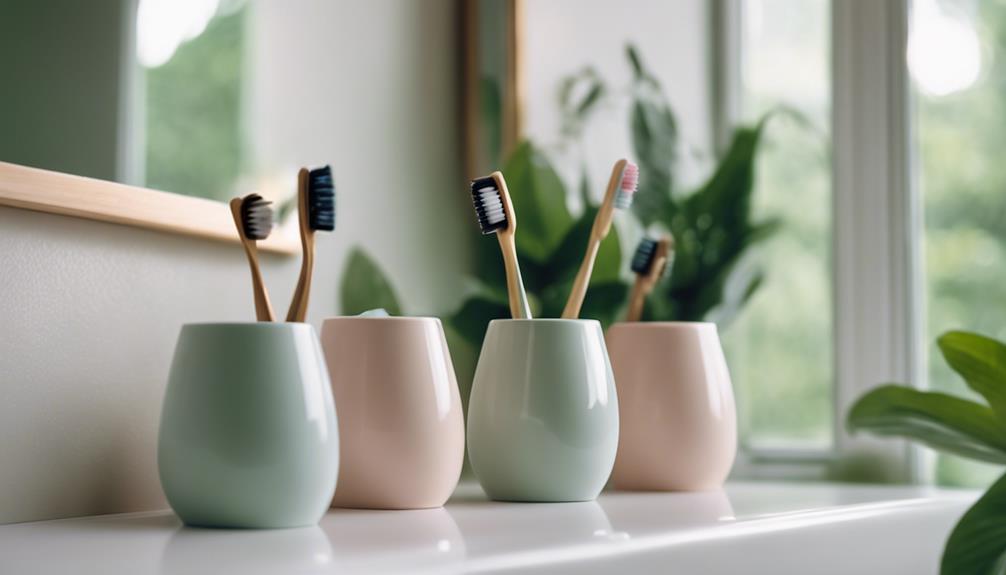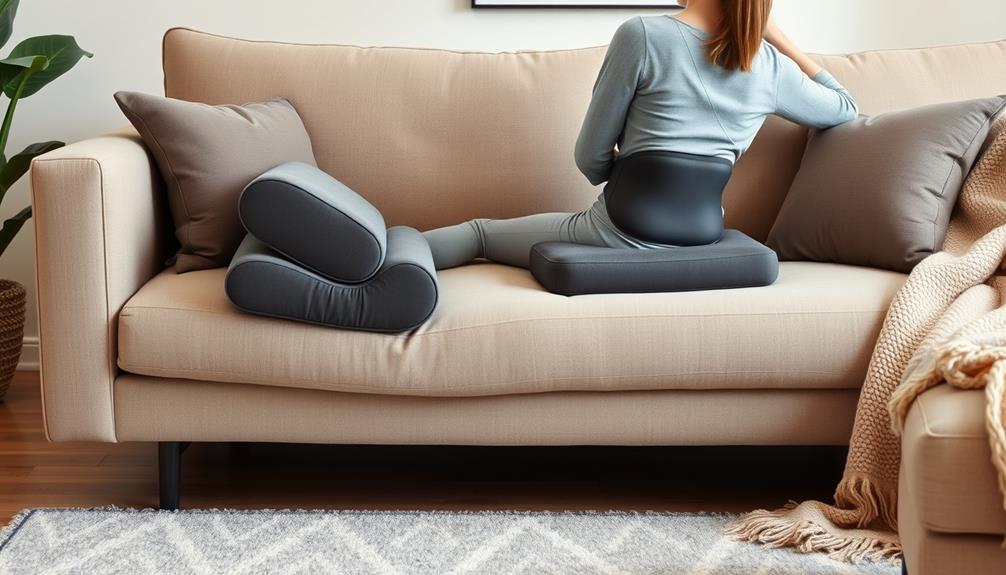To wrap your sofa for moving, start by cleaning it thoroughly. Vacuum and spot clean any stains to ensure it's in top shape. Next, use moving blankets to cover the sofa, securing them with packing tape to avoid slipping. If your sofa has removable cushions, wrap those separately. For added protection, consider using plastic wrap to guard against moisture and dirt. Make sure to secure all corners and edges as they're prone to damage. With these steps, your sofa will stay safe during the move, and there's more useful info on protecting your furniture ahead.
Key Takeaways
- Clean and dry the sofa thoroughly to prevent mold and mildew before wrapping for moving.
- Use moving blankets to cover the sofa, securing them with packing tape for added protection.
- Wrap the sofa in plastic wrap to shield it from dust, moisture, and potential damage during transit.
- Ensure the sofa is placed on a raised surface to minimize humidity exposure while moving.
- Inspect the wrapped sofa regularly during the move to address any potential issues like tears or moisture.
Introduction
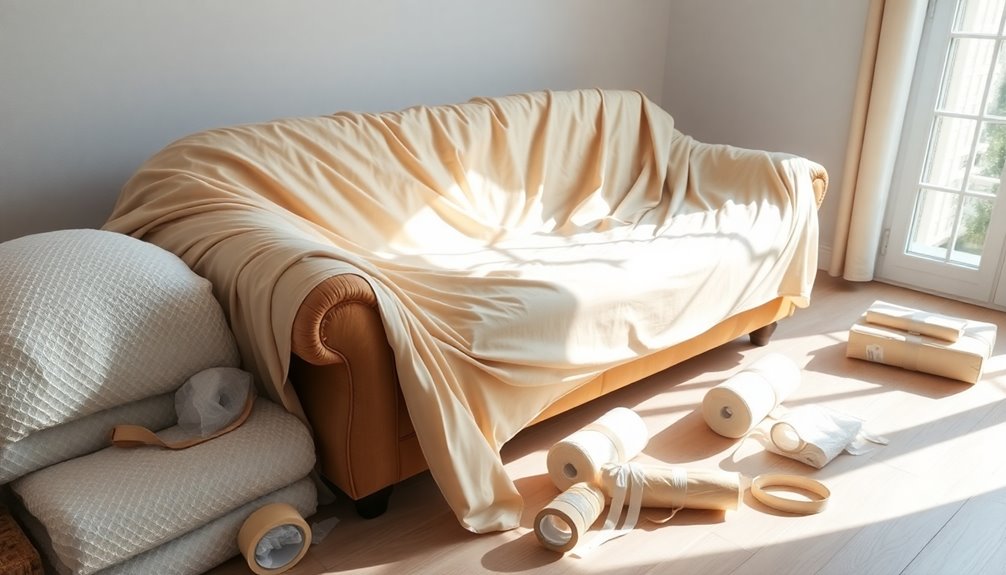
Keeping your sofa in top shape before a move starts with routine vacuuming and dusting to remove dust and debris. You should also know fabric-specific cleaning techniques to address any stains, like treating wine spills effectively. By taking these steps, you can ensure your sofa stays pristine during the moving process.
Routine Vacuuming and Dusting
To maintain your sofa's cleanliness and appearance, routine vacuuming and dusting are essential practices. By vacuuming at least once a week, you can effectively prevent dirt and allergens from accumulating in the fabric and crevices. Focus on areas where dust and debris gather, like under cushions and along seams. Make sure to use an appropriate vacuum attachment designed for upholstery; this way, you can remove dust without damaging the fabric.
In addition to vacuuming, regularly dust the sofa's surface with a microfiber cloth. This helps capture particles and avoids the buildup of allergens, keeping your living space healthier. Don't overlook the importance of these simple tasks; they can significantly extend the life of your sofa and maintain its aesthetic appeal.
For optimal maintenance, consider applying a fabric protector spray after cleaning. This creates a barrier against stains and spills, further enhancing the cleanliness and longevity of your sofa. By incorporating these routine vacuuming and dusting practices into your weekly schedule, you'll ensure your sofa remains inviting and comfortable, ready for use whenever you need it.
Fabric-Specific Cleaning Techniques
When it comes to cleaning your sofa, understanding the specific fabric type is crucial for effective maintenance. Each fabric requires tailored cleaning techniques to keep it looking fresh and new. For instance, microfiber can be wiped down with a damp cloth and a mild detergent, while leather needs a specialized cleaner to avoid damage. Always check the manufacturer's care tag, which indicates whether to use water (W), solvent (S), or either method (WS).
If your sofa is made of natural fibers like cotton or linen, vacuuming gently and spot cleaning with a mild detergent solution works wonders for stains without harming the fabric. Synthetic fabrics, such as polyester, can often handle machine washing, but you should use a gentle cycle and air dry to prevent shrinkage or distortion. When it comes to washing sofa covers, be sure to read the care instructions carefully. Some covers may be machine washable, while others may require professional dry cleaning to maintain their shape and color. Always test a small, inconspicuous area first before tackling the entire cover to ensure that the cleaning method you choose won’t cause any damage.
Regular maintenance is key; brushing and vacuuming not only preserve the appearance but also minimize the need for deep cleaning. By understanding and applying these fabric-specific cleaning techniques, you'll extend the lifespan of your upholstery, ensuring it remains a comfortable and stylish part of your living space.
Treating Wine Spills Effectively
A wine spill can be a nightmare for your sofa, but acting quickly can save your upholstery from lasting damage. Start by blotting the spill immediately with a clean, dry cloth or paper towel. This helps absorb as much liquid as possible without rubbing, which can spread the stain.
Next, mix a cleaning solution of one part white vinegar, one part dish soap, and two parts water. Gently dab this mixture onto the stained area to help lift the wine from the fabric. For stubborn stains, sprinkle baking soda over the affected area after applying the vinegar solution. Let it fizz for a moment, then vacuum it up to remove any remaining residue.
Always test any cleaning solution on an inconspicuous area of the fabric first to ensure it doesn't cause discoloration or damage. If the stain persists or if your couch fabric is delicate, don't hesitate to consult a professional upholstery cleaner for specialized treatment. They can provide the expertise needed to restore your sofa without risking further damage. Quick action and the right techniques can help keep your sofa looking great, even after an unfortunate wine spill.
Regularly Rotate Cushions

To keep your sofa looking great, it's important to regularly rotate the cushions. This simple step prevents uneven wear and sagging, which is especially crucial if you have pets or kids. Plus, using coasters for drinks can help protect the fabric, ensuring your sofa stays in top shape during its lifespan.
Pet-Resistant Fabric Choices
Choosing the right fabric for your sofa can make all the difference in keeping it intact despite your furry friends. Look for tightly woven materials like microfiber or canvas, as they're less prone to snagging and tearing from claws. Fabrics with a higher rub count, specifically those rated over 30,000 double rubs, offer enhanced durability against wear and tear caused by pets.
Incorporating removable cushion covers made from pet-friendly fabrics can significantly ease your cleaning routine. You can toss them in the washing machine when they get dirty, which saves you time and hassle. It's also wise to consider treated fabrics with stain-resistant or water-repellent finishes to protect against accidents and spills.
Regularly rotating your cushions not only helps in distributing wear evenly but also prolongs the life of the fabric. By maintaining this practice, you'll keep your sofa looking fresh and well-kept, even with daily pet usage. In the end, selecting the right materials and implementing these strategies ensures that your sofa remains a stylish and functional part of your home, even with your furry companions around.
Pet-Friendly Fabric Options
When it comes to selecting pet-friendly fabric options for your sofa, you'll want materials that stand up to the wear and tear from your furry companions. Look for pet-friendly fabrics like microfiber and tightly woven textiles, which resist stains and make cleaning easier. Regularly rotating cushions is vital, as it helps prevent uneven wear and prolongs your sofa's lifespan while keeping it looking fresh.
Opt for materials with a protective coating, as they repel pet hair and moisture, reducing maintenance tasks. Leather and faux leather are also excellent choices, as they're typically easier to clean and less likely to absorb odors from pets. Implementing a routine of vacuuming and spot cleaning will further help maintain the appearance of your pet-friendly fabrics. Additionally, consider incorporating high-quality protein sources into your pet's diet to support their overall health, ensuring they remain happy and less prone to destructive behavior.
Using Coasters for Drinks
Protecting your sofa from drink-related damage starts with using coasters. By placing coasters under every beverage, you can effectively prevent moisture rings and stains on your couch. It's a simple step that goes a long way in maintaining the appearance of your upholstery.
Designate specific areas for drinks to encourage your family and guests to use coasters consistently. This helps minimize spills and keeps your living space tidy. Opt for absorbent coasters that wick away moisture more effectively, ensuring your sofa stays safe from damage.
Educate your friends and family about the importance of coasters. When everyone understands that these small items can significantly protect your couch, it fosters a culture of care and respect for your furniture. Regularly rotating your cushions also plays a key role in preventing uneven wear and sagging, further extending your sofa's life.
Fabric Tear Fixes
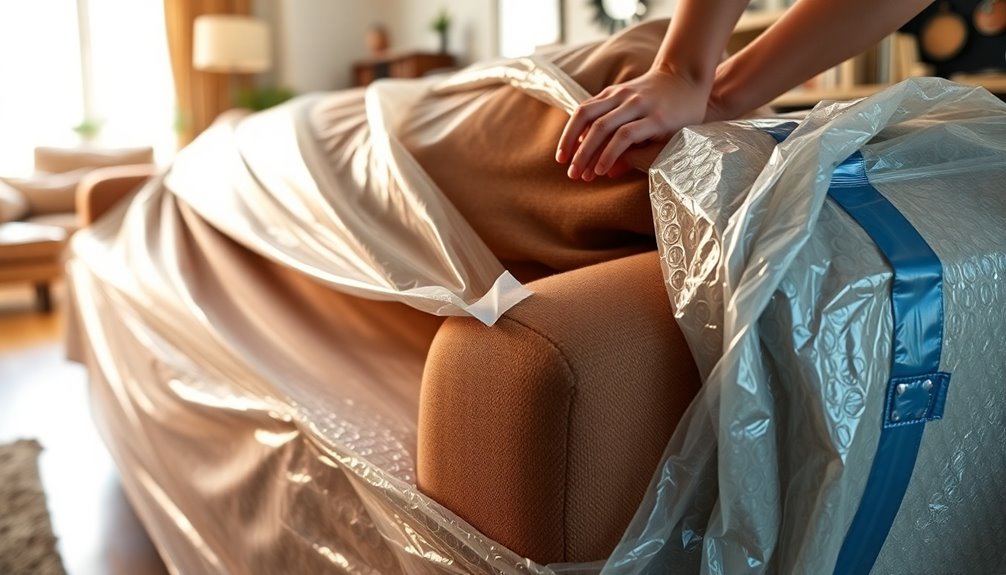
When it comes to fabric tear fixes, you might also want to consider the overall condition of your couch. Check for any frame damage or instability that could worsen the situation, along with applying leather conditioning treatments if your sofa is made of leather. Additionally, explore couch rejuvenation techniques to restore its appearance and extend its lifespan.
Frame Damage or Instability
Inspecting your sofa before moving is crucial to avoid further damage. Start by checking the frame for any visible signs of damage, like cracks or loose joints. If you spot issues, use wood glue or epoxy to reinforce those weak areas. Make sure to allow sufficient drying time before you begin wrapping the sofa.
Next, look for fabric tears or frays. Apply a fabric patch or upholstery adhesive to securely cover these areas, preventing further damage during the move. If you notice minor scratches or dents on the frame, consider using a furniture repair kit. These kits often include fillers and color-matching tools to help restore the sofa's appearance.
After addressing all repairs, it's time to protect your newly fixed sofa. Cover the entire piece with moving blankets, ensuring every part is shielded. Once covered, secure the blankets with plastic wrap. This final step is vital, as it'll help protect both the frame and fabric from any additional damage during transport. By taking these precautions, you can ensure your sofa arrives at your new home in great shape.
Leather Conditioning Treatments
Before you start wrapping your leather sofa for the move, it's essential to give it a little TLC with a leather conditioning treatment. These treatments are designed to nourish and protect leather surfaces, preventing cracking and wear over time. This is crucial during a move, as the stress on the material can lead to damage.
When applying a leather conditioner, use a soft cloth and follow the manufacturer's instructions to ensure even coverage. Avoid over-saturating the material, which can cause issues. Regular conditioning every 6 to 12 months keeps the leather supple and resistant to damage, especially before a move.
If you notice minor fabric tears, consider using a specialized leather repair kit to restore the integrity of your sofa. These kits often come with color-matching compounds for a seamless finish. Remember to test any conditioning product on a hidden area first to ensure compatibility with your specific leather type and finish. This precaution helps avoid potential discoloration or damage. By taking these steps, you'll protect your leather sofa and keep it looking its best throughout the moving process.
Couch Rejuvenation Techniques
Couches can suffer from minor fabric tears over time, but fixing them doesn't have to be a daunting task. For small tears, you can easily use a fabric patch or iron-on mending tape to cover the damaged area. Just make sure the fabric grain aligns for a seamless look. If the tear is larger, grab a needle and thread, and stitch the edges together with color-matched thread to minimize visibility.
For frayed edges, upholstery glue offers a quick solution. Apply a small amount to the affected area, press it down firmly, and let it set. If you're dealing with a leather sofa, a leather repair kit is your best bet. These kits usually include color-matched dye and a filler compound to effectively conceal and mend tears.
To prevent future damage, regularly applying a fabric protector can be a smart move. It helps extend the lifespan of your sofa upholstery, making it more resistant to stains and wear. With these simple techniques, you can keep your couch looking great for years to come!
Custom Upholstery Fabric Choices
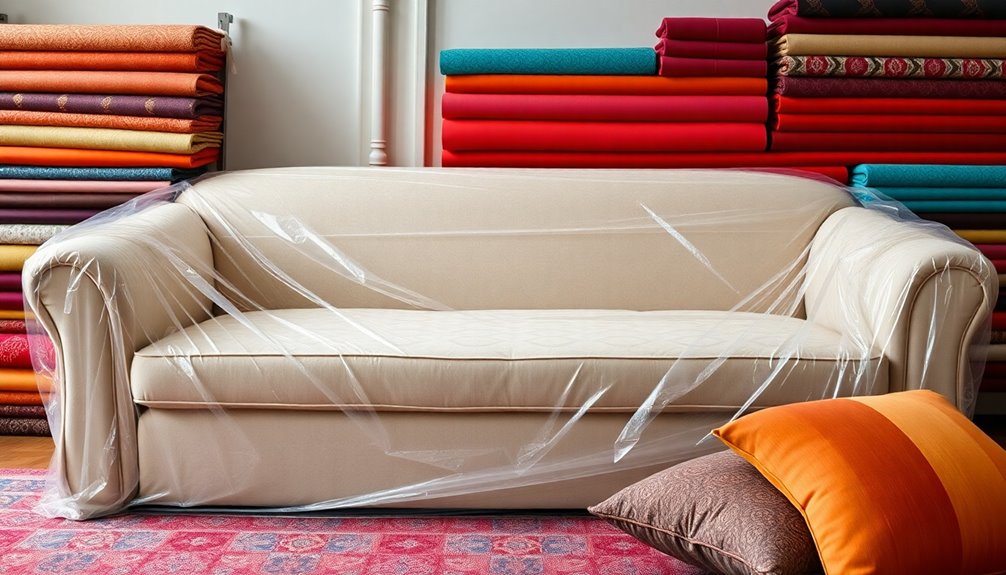
When choosing custom upholstery fabric for your sofa, you'll find that the options can greatly enhance both its durability and aesthetic appeal. You'll encounter a range of materials, from natural fibers like cotton and linen to synthetic choices such as polyester and nylon. If you have pets or kids, consider performance fabrics that are stain-resistant and easy to clean, like microfiber or treated polyester.
Pay attention to the fabric's abrasion resistance rating, which is measured by the Wyzenbeek test. A rating of 15,000 double rubs or higher indicates good durability for everyday use, ensuring your sofa withstands daily wear and tear.
The color and pattern of your upholstery fabric also matter. Lighter shades can make a room feel larger, while darker tones add warmth and coziness. Plus, custom upholstery allows you to explore various textures like velvet, leather, or canvas, each providing a unique tactile experience.
Seasonal Storage Tips
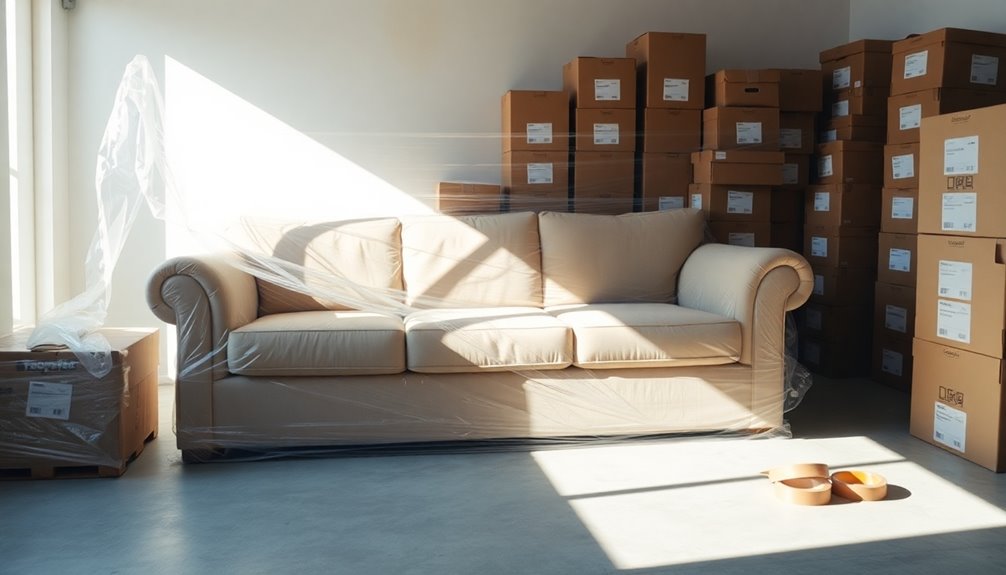
Proper seasonal storage can extend the life of your sofa and keep it looking great. Start by thoroughly cleaning and drying the sofa to prevent mold and mildew during storage. Use breathable fabric covers instead of plastic to protect the sofa from dust while allowing for air circulation, which helps prevent moisture buildup.
Place the sofa on a raised surface, like pallets, to keep it off the ground and minimize exposure to humidity and pests. This simple step can make a significant difference in maintaining its condition.
When packing your sofa, utilize moving blankets or bubble wrap to cushion it, especially if you're stacking it with other furniture. This will help protect it from scratches and dents.
Don't forget to check on your stored sofa every few months. Regularly inspecting it allows you to address any potential issues, such as pests or moisture, before they cause significant damage. By following these seasonal storage tips, you'll ensure your sofa remains in great shape, ready for use when the season changes.
Conclusion
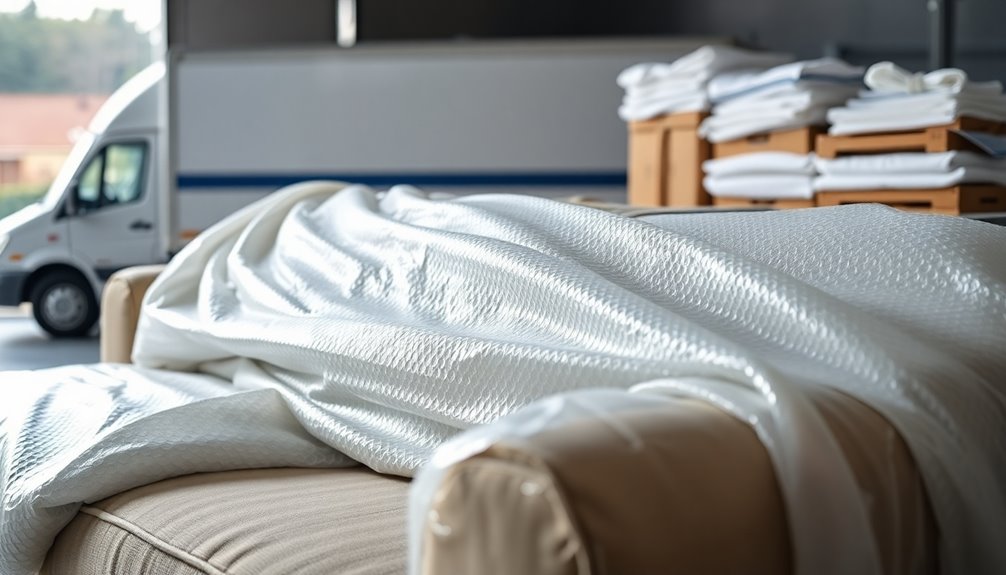
Taking care of your sofa during storage sets the stage for an easier moving process. By properly wrapping your sofa, you ensure it arrives at your new home in the best condition possible. Start by removing cushions and any detachable parts to lighten the load and prevent damage. Use moving blankets to cover the entire sofa, making sure every area is protected from dirt and scratches. Once the blankets are in place, apply plastic stretch wrap tightly to secure everything. This will help keep the blankets intact and shield your sofa during transport.
For extra protection, especially if your sofa has delicate fabrics, consider using bubble wrap or additional layers of moving blankets in high-impact areas like corners and edges. After wrapping, don't forget to label the sofa for easy identification—this will save you time and confusion on moving day. Lastly, when loading the sofa into the moving vehicle, ensure it's secured properly to prevent shifting, which can lead to damage. By following these steps, you'll safeguard your sofa and make the moving experience smoother for yourself. Additionally, regular grooming can help reduce pet hair accumulation on your sofa before you move.
Frequently Asked Questions
How to Wrap up a Couch for Moving?
When you're getting ready to move, wrapping up your couch properly is essential. Start by removing all cushions and detachable parts to avoid damage. Cover the couch with moving blankets and secure them with packing tape. Next, use plastic stretch wrap to protect against dirt and moisture, ensuring it's tightly wrapped. For extra protection on delicate areas, consider bubble wrap. Finally, label the wrapped couch for easy identification when you unpack.
What to Cover a Couch With When Moving?
When you're moving, it's crucial to cover your couch properly. Start with moving blankets to cushion it and prevent scratches. Then, use plastic stretch wrap to secure the blankets and guard against dirt and moisture. For delicate sofas, bubble wrap on vulnerable areas offers extra protection. Make sure to secure everything with packing tape to keep it in place. If your couch is leather, add more blankets to avoid damage and discoloration.
How to Plastic Wrap a Sofa?
To plastic wrap a sofa, start by removing all cushions and detachable parts. Next, use a moving blanket to cover the entire sofa, which protects it from shocks and scratches. Then, take your plastic stretch wrap and begin wrapping at one end, overlapping as you go to secure the blanket. Make sure to focus on corners and edges for extra protection. Finally, seal the ends with packing tape to keep everything secure.
How Do You Protect Couch When Moving?
To protect your couch when moving, start by covering it with moving blankets to shield it from scratches and dirt. Then, use plastic wrap to secure the blankets and keep moisture out. If your couch has removable parts, take them off and wrap them separately. Finally, use straps to secure the couch in the moving vehicle, preventing it from shifting. Don't forget to label it for easy identification when unloading!
